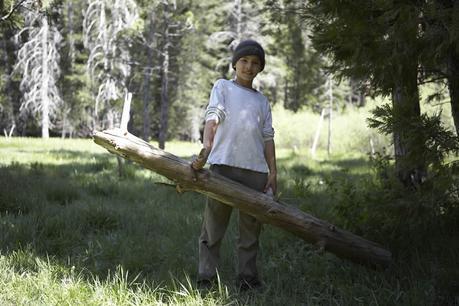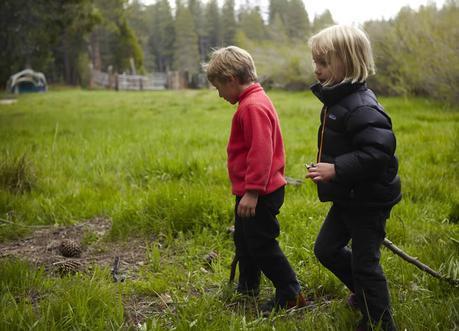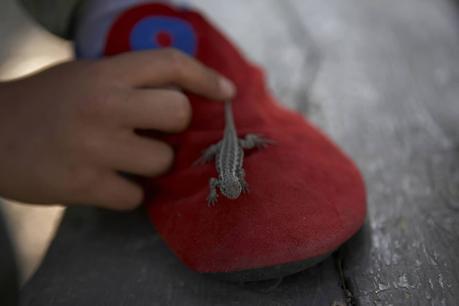
"For 99 percent of the time we've been on Earth, we were hunters and gatherers, our lives dependent on knowing the fine, small details of our world. Deep inside, we still have a longing to be reconnected with the nature that shaped our imagination, our language, our song and dance, our sense of the divine." - Janine M. Benyus
What can be learned from an hour in the woods? Little perhaps, at first. The sights, sounds, and sensations can be unfamiliar and overwhelming, leaving you itching for a little magic screen to help you pass the time, or at least make sense of what’s around you.
What if you stack on a few more hours? By now, chances are the boredom has faded and you’ve started looking around, becoming more aware of the surrounding world and its inhabitants.
This natural learning progression is the foundation of the “Waldkindergarten,” or “Forest Nursery,” where children begin their “formal” education amid trees and streams, frogs and butterflies. Embraced for decades in Germany, Switzerland, and much of Scandinavia, Forest Kindergartens have only recently made their way to North America but have quickly made a big impression. Soft Star believes that humans are amazing by nature and that frequent, varied, functional motion helps us experience the world in a richer way. Consequently, we are deeply intrigued by the potential of forest schools and the self-motivated exploration they promote; note the term “explore,” the physical and mental seeking of answers and the learning that happens along the way. Might learning this way bring a greater variety of benefits than “Googling” something, or choosing the correct answer from a list of four, or relying on the nearest “teacher” to provide the truth? Here’s what we discovered.

Waldkindergartens vary in format, tailoring their elements to different age groups and locations. Generally, a “class” made up of around 20 pre-schoolers and kindergartners meets five days a week, around 6 hours a day with one lesson plan: learning through independent, free, outdoor play. Every day. In virtually any weather. A trained teacher or two and perhaps a parent volunteer oversee the children with minimal interference, guiding a few fluidly structured learning activities but primarily working in the background, occasionally asking or answering questions to help students advance their daily explorations.
Safety is sometimes taught and occasionally enforced by adults, but not by the usual restrictive methods of protection. Craft time might include whittling wood with knives, and playtime will almost certainly include tree climbing, hill-rolling, and other adventurous behaviors. Rather than removing all potential threats, instructors watch as children largely teach themselves the limits of safe behavior. Supporters believe that taking small, calculated risks while young prepares children to choose when to take larger leaps later in life, giving them a reliable sense of their capabilities that tells them when to jump in, and when to hold back.
This sense of self-control is just one of the critical life-skills acquired by interacting with nature. Natural playgrounds also promote hands-on problem solving by offering mental and physical challenges that prompt early forays into the scientific method, sparking hypotheses, experimentation, analysis, and adjustments until goals are either achieved or are given up to the sheer joy of the learning process. When these efforts are successful, students are rewarded with a priceless prize: confidence in their abilities to face and overcome novel problems by drawing on their own talents and those of others. They are stronger at the end of the process too, building up the physical, mental, and emotional stamina they will need for more structured, “focused” learning later in their educational careers.
American educators have greeted these schools with a mix of trepidation and intense interest. In an age where schools are confronted with health and behavioral disorders at alarming rates among their students, from AD/HD to childhood obesity, many education researchers are examining the possible ties between these rising problems and another US trend of the last two decades: the disappearance of recess. Almost half of American preschoolers get no regular outdoor recess [1], raising serious concerns for child development experts. In a widely-read article for the Washington Post, pediatric occupational therapist Angela Hanscom discusses how the disturbing consequences of sedentary learning play out in one fifth grade classroom during story time:
“I’ve never seen anything like it. Kids were tilting back their chairs back at extreme angles, others were rocking their bodies back and forth, a few were chewing on the ends of their pencils, and one child was hitting a water bottle against her forehead in a rhythmic pattern. This was not a special-needs classroom, but a typical classroom at a popular art-integrated charter school….We quickly learned…that most of the children in the classroom had poor core strength and balance. In fact, we…found that when compared to children from the early 1980s, only one out of twelve children had normal strength and balance. Only one!”[2]

In spite of obvious short-comings in the way schools currently integrate a child’s need to move into the learning process, even educators who fully support more free play often feel powerless to offer their students something better. Traditional public kindergartens that receive government funding are subject to specific state and national educational standards; if standardized test results show that the average student has not met government-mandated learning objectives, funding is withdrawn and the school is left to close a widening achievement gap with narrower resources. Such high stakes leave few schools willing to risk dramatic program overhauls, fearing that if students venture off the beaten path, they might not find their way to the designated learning checkpoint in time to be counted successful[3].
Although it seems such fears may be unfounded. European nature schools seem to be setting children up just fine for long-term academic success (and good physical health!)[4], and similar results have been reported in early observations of forest school graduates in the US as well. One Vermont public school instituted “Forest Monday”, dedicating one full school day a week to free-form, outdoor learning. After one year with the program in place, standardized test scores rose more than in any other previous year[5]. And even if students did not score as well according to current measures, it would not necessarily reflect losses in learning; experts argue that multiple-choice bubble tests and the drills that prepare students for them are not developmentally-appropriate for evaluating kindergartners, who learn best through the complex, multi-sensory, non-linear experience of play. Curiosity fuels the growth and development of active minds as food nourishes active bodies, and it seems both may be best when organically cultivated.
Perhaps this research explains why so many parents are willing and eager to trust their children to nature schools, despite the fact that virtually none of these programs are licensed in the US. Current regulations make it effectively impossible for forest schools to obtain preschool or kindergarten certifications. Standards created for indoor spaces mean that even Cedarsong Nature School, America’s oldest and most esteemed forest kindergarten, has no official recognition of its credentials. After all, how can an entirely outdoor program keep its “classrooms” insect- and rodent-free, or make sure that all climbing structures are no more than 6 inches off the ground? Some nature schools are currently working with state education boards to adapt licensing standards for outdoor learning. In the meantime, Cedarsong may be without a license, but it does have its own teacher training protocol; outdoor educational programs for young children, adults and families; nature immersion therapy programs for children with sensory processing disorders; and a waitlist where parents enroll their children years in advance.

The lack of recognition from mainstream educational authorities may fail to deter many families from seeking out nature kindergartens, but tuition costs of raise another potential barrier. Social equity is a major part of the sustainability-focused curriculum at the core of most nature schools, and programs use a variety of means to try to make enrollment accessible to all interested children, regardless of economic resources. The well-regarded Fiddleheads Forest School, sponsored by the University of Washington, offers programs which range in price from $3200 to $7600 annually (depending on the number of days of week attended); even with this price tag, Fiddleheads still has to select its classes by lottery each year to deal with its surplus of applicants.
On the other hand, Cedarsong operates under the umbrella of the non-profit Ancient Forest Preservation Foundation, which accepts donations that help fund the school’s operations and scholarships for low-resource families[6]. Tiny Trees, a newer program based in Seattle, offers a sliding scale and partially offsets tuition with funding from the city (and provides each child with a full-body rain suit)[7]. Considering the fact that Tiny Trees has been able to enroll 150 students for the price of teaching 20 in a standard indoor classroom, proponents hope that nature schools’ ability to stretch an educational budget might facilitate their acceptance by other local and state governments, helping to overcome both of the most significant obstacle facing outdoor kindergartens today.
Educators have devoted so much energy to restructuring every aspect of classroom time, yet American children continue to struggle to develop healthy bodies and minds; perhaps, at long last, it’s time to give recess another look.
Other Outdoor Education Resources:
- Children & Nature Network
- EcoAmerica's Nature Rocks
- The Walking Classroom
[1] Nearly Half of Preschool Children Not Taken Outside to Play by Parents on a Daily Basis: Study
[2] Why So Many Kids Can’t Sit Still in School Today
[3] Is Kindergarten Too Young to Test
[4] Udeskole in Scandanavia: Teaching and Learning in Natural Places
[5] Out Of The Classroom And Into The Woods
[6] Cedarsong Nature School: Scholarship Fund
[7] Outdoor Schools Open Up New, Affordable Adventures In Learning
Related Posts:
- Top 10 Balance Games for Kids...of All Ages
- Our Newest Kids Shoe is Now Available: Meet Merry Jane!
- National Park Shoes for the Whole Family

